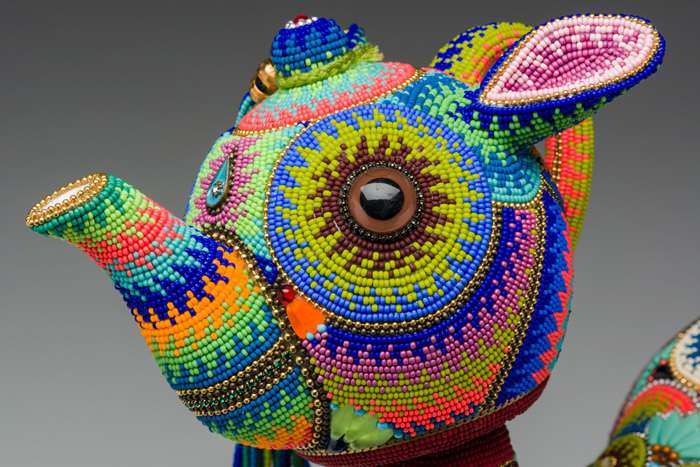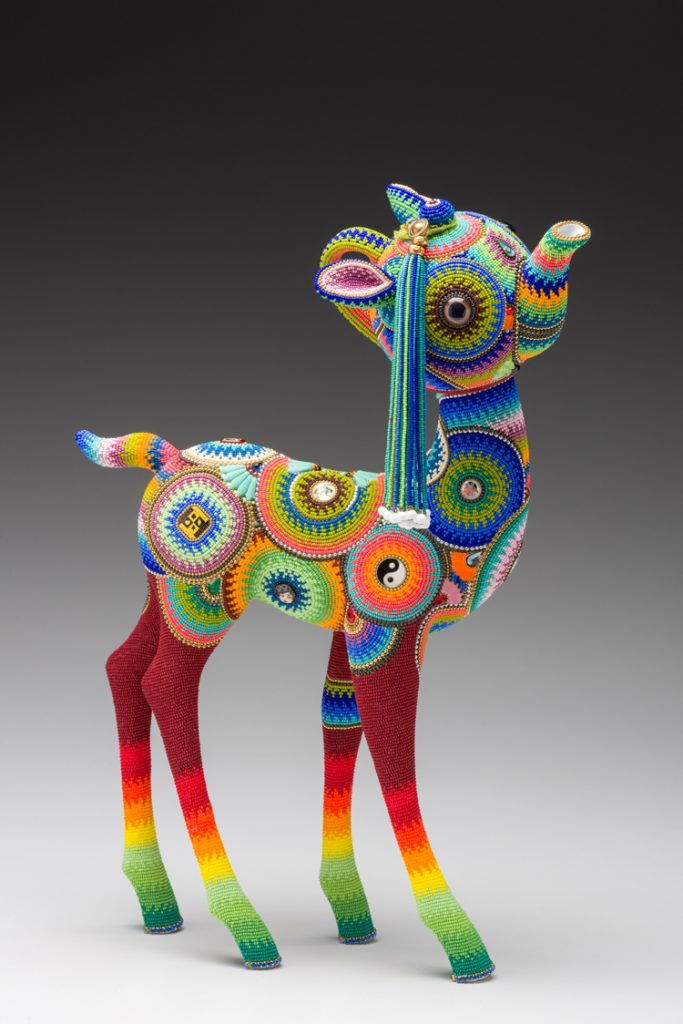“With each new row of beads, I more clearly see the personality of the piece emerging and it tells me what color needs to follow, what line needs to intersect. I listen.”[i] -Jan Huling
Jan Huling is known for her meticulous use of seed beads which she applies in intricate patterns on a range of three-dimensional forms. These forms are objects from everyday life, such as a doll or a plastic toy, but once they are covered with beads, they are transformed. Inspired by indigenous art, mythologies, and pop culture, her swirling hypnotic surfaces often remind us of the fantastical creatures found in childhood fairytales.
Huling was born in Chicago, but grew up in St Louis, Missouri. She credits her mother, who is a quilter, as “[her] earliest influence.”[ii] Huling “was raised a firm believer in the power of craft” and from a young age she knew she wanted to be an artist. After receiving a Bachelor of Fine Arts from Kansas City Art Institute, Huling began her career at Hallmark Cards.[iii] Then, after five years at Hallmark, she and her husband moved to New York City where she freelanced as a product designer for approximately thirty years.[iv] Her freelancing projects ranged from the creation of textile designs to dinnerware and holiday décor.
Beading Begins
In 2001 Huling’s sister, who is a jewelry designer, visited her. She brought with her a Pez candy dispenser that she had covered with beads. Huling was fascinated and had to give this process a try. The first object she beaded was a kazoo. Huling immediately “knew [she’d] found her thing.”[v] Soon she was covering a variety of larger objects in beads, buttons, coins, and tokens.
Huling’s work has gained widespread attention in a relatively short period of time. She stepped away from freelancing as a product designer in 2008 in order to focus on her beading full-time. In recent years Huling’s sculpture has been shown at national art fairs and museums such as the Montclair Art Museum in Montclair, New Jersey and the American Visionary Art Museum in Baltimore, Maryland.
The Kamm Collection & Pothead
The Kamm Teapot Foundation has multiple examples of Huling’s work in its collection. For the purposes of this blog post, we will highlight one sculpture called Pothead. Created in 2012, this form appears to be simply a deer. However, upon closer inspection, it becomes apparent that the deer’s head is in fact a teapot (hence the witty title). Pothead’s surface contains some small found object accents, but the majority is covered in poppy seed-sized beads. Striped configurations of beads in green, yellow, orange, and red encircle the deer’s legs while a concentric circle design in a range of colors coats the rest of body. In addition, Huling attached a removable tassel with blue and green strands to the teapot head and a beaded butterfly to deer’s body near its tail.
When Huling begins a work like Pothead, she “[goes] through all the great crap in [her] studio first.”[vi] She is always looking for interesting objects that can be utilized for her next sculpture. Huling lets her surface designs evolve organically. After years of doing sketches for commercial clients, she “[doesn’t] want to do that step anymore.”[vii] Instead, Huling does “free range beading!”[viii] However, it is a “very slow zen-like process.[ix] Each bead is first strung on a thread and then, once they are glued down, the thread is removed. Huling’s glue is applied using an air pen, which works like an airbrush, to create thin lines of adhesive. Although works like Pothead also include small objects such as ball chains and rhinestones, she relies heavily on glass seed beads from the Czech Republic. Huling is drawn to their imperfections. She has said that “…some are squished on one side and perfect for filling an odd space. I love how very human and warm they are…”[x]
As Huling’s work evolved, she began combining multiple objects to create the armature for her sculpture. At times this involves “Frankensteining forms together.”[xi] Pothead, with its deer body and teapot head, is an example of this development. However, once beaded, these dissimilar objects become one. All of the “usual connotations” disappear and we are left contemplating the emergence of a new creation.[xii] These new creations are humorous playful characters that could easily be found in a fairytale story or perhaps some mythological world.
Ultimately, it is Huling’s surface designs that mesmerize. Her intricate, colorful, repetitive beading on works like Pothead are visually stimulating as well as tactile.[xiii] Huling believes that by “ornamenting their surfaces, [she] bring[s] out the magic and elegance of their basic shapes.”[xiv] The inspiration behind these patterns is wide-ranging. Huling might be inspired by traditional Mexican art and culture or a recent trip to the movies.[xv] A connection can certainly be drawn between Pothead and Huichol art. The Huichol are an indigenous Mexican tribe that is known for their sophisticated vibrant beadwork. However, Huling’s “techniques and artistic vision” are completely different. She makes “approachable evocative objects that elevate the everyday.”[xvi] Huling says, “My work is a true labor of love…I create each piece to amuse and delight myself…The fact that others are inspired by my stuff is a joy to me.”[xvii]
Further Reading/Viewing:
Golden, Suzanne. Suzanne Golden Presents Interviews with 36 Artists Who Innovate with Beads. New York: Lark Crafts, 2013.
Jan Huling, Beadist. State of the Arts. NJN Public Television. PBS. December 14, 2011.
Jan Huling. Speakeasy Art Gallery. September 18, 2013.
Sikes, Gini. “Zoom.” American Craft 3. June/July 2011. 12-13.
Notes:



